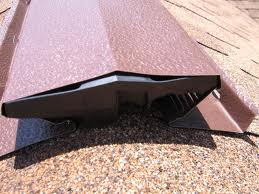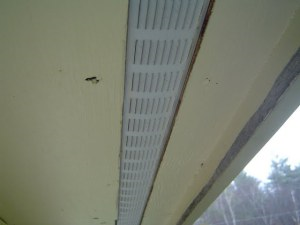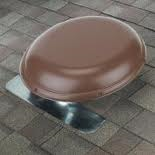|
Home Inspectors Edition | Circulation 20,000 | Advertise | Subscribe | |
Published by OREP, E&O Insurance Experts | October 2013 |
 Click to Read Current Issue |
>
Click to Print
Note: If you live in a “higher-priced” state like
Calif., NJ, PA, FL or TX, OREP does not limit coverage or raise rates on you. Same rates apply in all states
where this program is offered.
>
Approved Inspector Continuing Education at
Discount
|
Some signs to look for in attics regarding ventilation can include attic
mold, condensation on sheathing or rafters/trusses, wet insulation, or
excessive attic heat.
Attic Ventilation
By Matthew
Steger, ACI
Whether you are installing a new roof material or simply evaluating a
roof’s current condition, paying close attention to attic ventilation is
critical for several reasons.
Some of the reasons adequate attic ventilation is important include:
-
Keeping the home cooler in the summer. An abundance of summer heat trapped in the attic due to little or no ventilation can make the home more expensive to cool.
-
Limiting ice dams in the winter. Ice dams are caused by warm (usually improperly ventilated) attics that allow snow on the roof above to melt. As the melted water runs down the roof, it reaches the overhanging eaves. Since eaves are generally not above the attic or living space and therefore not heated, cold winter air can refreeze this melted snow allowing for it to find its way back up under the shingles. This can lead to rotted soffit, fascia, and trim boards, water infiltration into the home, and possibly present an attraction to insects.
-
Damage to the shingles themselves. Intense summer attic heat from an improperly ventilated attic can actually bake the roofing materials (shingles, sheathing, etc.) from underneath over time, thus causing premature deterioration of the various roofing materials.
-
Moisture condensation on the underside of the roof sheathing can lead to damaged attic and roofing wood and mold growth. Mold growth can lead to health issues to those living in the home. Attic moisture can also lead to roof decking expansion and waviness.
The purpose of proper attic/roof ventilation is to allow cool air to
enter the attic at the soffits, rise uniformly up the underside of the
roof sheathing, and exit at the ridge venting. In perfect
ventilation conditions, the attic’s air temperature should essentially
match that of the exterior air temperature. Proper insulation on
the attic floor helps keep the living space comfortable.
Most roofing material manufacturers these days have explicit installation procedures regarding minimum required attic ventilation. These must be met in order to maintain product warranties.
HUD and most building codes require a minimum 1 square foot of attic
ventilation for every 150 square feet of attic floor space, however when
half of the ventilation is at the roof’s ridge (peak) and half is at the
soffits/eaves, this ratio may be lowered to 1 square foot ventilation
for every 300 square feet of attic floor space. It is best to have
balanced ventilation between the ridge and soffit venting, however, when
this is not possible (such as when the home has a hip roof), studies
have shown it is best to have more ventilation at the soffit.
Gable venting:

Ridge venting:

Soffit venting:

Certainteed®, a major roofing material
manufacturer, requires that when ridge and soffit venting is added to a
Certainteed® shingled roof that has gable, box, or power vents, these
old vents must be covered or removed. This requirement is
explicitly stated in the CertainTeed® Shingle Applicator's Manual.
Who wants to pay thousands of dollars for a new roof only to find out
that the roofer cut corners and did not install adequate attic/roof
ventilation and the new roof warranty is now void?
On multiple occasions, I have seen relatively
new roofs installed with little or no ventilation, an issue arises due
to premature deterioration and the shingle manufacturer is called.
In both cases, a shingle manufacturer’s representative visits the home
to evaluate the situation and determines that the minimum amount of
attic ventilation wasn’t met upon installation (per installation
instructions), and voids the shingle warranty on the spot!
More than a handful of time, I have inspected
homes with fairly new roofs, ridge venting is installed on the exterior
of the roof, but when I get into the attic, I come to find that the
roofer never cut holes in the roof sheathing to allow the ridge venting
to serve any purpose.
Again, the purpose of venting is to allow for a
uniform air flow along the underside of the roof. When additional
ventilation is present such as box vents or power fans, the uniform air
flow can be interrupted creating hot spots in the roof. Under
certain conditions, these extra vents can even allow hot air to enter
the attic through the ridge venting. The overall roof and attic
ventilation can be effectively lowered and, as previously stated, can
altogether void the shingle manufacturer’s warranty.
In-depth studies performed by building science
experts have shown that attic (roof or attic wall mounted) power vent
fans tend to pull moisture and conditioned air up through the home into
the attic. This can also lead to mold growth in the attic in some
cases. This movement of air also results in wasted energy dollars
as conditioned air is lost into the attic. Hot air may actually be
pulled back into the attic under some circumstances. Also,
back-drafting of fossil fuel appliances (such as furnaces, fireplaces,
and water heaters) and the introduction of potentially dangerous exhaust
gases, such as carbon monoxide, into the home may occur. When air
is vented out of the home, make-up air must be supplied from somewhere
and this air is most often from within the home.
Think of a hot summer day and your home has
central A/C and a roof or attic mounted power vent fan. Your home's
A/C system is running and, since your attic is also hot, your power vent fan
is also running. Since this vent is essentially sucking air out of the
attic, make-up air needed to fill the attic (to replace the hot air leaving
the power vent) enters from the home. This make-up air is the very
same air that you already paid to cool. So, in essence, you're paying
to cool your home, then paying to suck hot air out of the attic, then
essentially paying more to cool your home even more because the air you
already paid to cool is being sucked out through your attic. The
solar-type of attic vent fan causes the same pattern, although the fan
itself doesn't consume electricity.

While taking actual mechanical measurements to see if the minimum required
attic ventilation is met in a given home is generally outside the scope of a
home inspection (based upon the Standards of Practice of the American
Society of Home Inspectors [ASHI]), it is prudent for the home inspector to
make comments and recommendations regarding an observed lack of or apparent
insufficient ventilation. The home inspector has a duty to his client
to report on possible issues, such as this.
Some signs to look for in attics regarding ventilation can include attic
mold, condensation on sheathing or rafters/trusses, wet insulation, or
excessive attic heat. Most inspectors carry laser thermometers, so
measuring a hot attic’s temperature takes mere seconds. Also, all
bathroom and kitchen exhaust ventilation fans should empty to the exterior
of the home and not into an attic. Exhaust fans emptying into an attic
can allow for damage to roof sheathing, attic mold, and attraction to
insects.
About the Author
Matthew Steger, owner/inspector of WIN Home Inspection, is a Certified Level
1 Infrared Thermographer and an ASHI Certified Inspector (ACI). He can
be reached at: 717-361-9467 or
msteger@wini.com. WIN Home Inspection provides a wide array of home
inspection services in the Lancaster, PA area. This article was
authored by Matthew Steger, ACI - owner of WIN Home Inspection in
Elizabethtown, PA. No article, or portion thereof, may be reproduced
or copied without prior written consent of Matthew Steger.
ATTENTION: You are receiving WRE Online News because you opted in at WorkingRE.com or purchased E&O insurance from OREP. WRE Online News Edition provides news-oriented content twice a month. The content for WRE Special Offer Editions is provided by paid sponsors. If you no longer wish to receive these emails from Working RE, please use the link found at the bottom of this newsletter to be removed from our mailing list.






